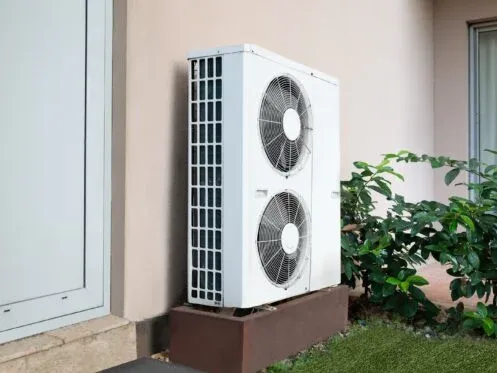Ductless mini-split systems provide high performance and highly efficient cooling. They’re perfect for older Sacramento, CA homes that lack the ductwork to support central HVAC. They’re also an excellent choice for properties with remote, unserviced areas. Whether you have yet to get a fixed, whole-house cooling solution or simply need better climate control in your basement, attic, or garage, a mini-split could be the ideal choice for you. However, before you commit to this installation, there are several important things to know about a mini-split’s electricity use.
How Much Electricity Does a Mini-Split System Use?
According to both well-known HVAC equipment manufacturers and ENERGY STAR, ductless mini-split systems use far less energy than central air conditioners. By some estimates, ductless mini-splits use 30% to 50% less electricity than their ducted alternatives. Depending upon where and how they’re used, ductless mini-splits often draw between 400 and 1,500 watts per hour whereas central ACs can use between 3,000 and 5,000 watts per hour.
Why Ductless Mini-Split Systems Are More Efficient
Central air conditioners have an outdoor condenser unit and a single indoor air handler. This air handler moves cooled air to ducting that distributes it to every room. Standard, central ACs create a single, uniform temperature throughout buildings. With just one thermostat governing their operations, central cooling systems run until every room reaches the temperature set on this device.
In comparison, ductless mini-split systems have multiple air handlers and thermostats. Residents can set and adjust each thermostat and air handler independently of the others.
Customized Cooling
An often-cited drawback of installing a central cooling system is their inability to provide customized comfort to suit the needs of multiple residents. With uniform cooling, you might deal with frequent arguments over thermostat settings. Some people might be too cold while others aren’t cool enough.
With a mini-split system, there’s less likelihood of having residents crank thermostats way up or way down to alleviate their frustration. These systems can provide service to as many as eight separate zones or rooms. When people leave the home or have different cooling preferences, they can adjust the thermostats in their immediate areas as needed. For instance, if the entire first floor of your home is empty, you can turn all downstairs air handlers off and only use electricity for top-floor cooling.
No Duct-Related Energy Losses
According to studies performed at the University of Florida, HVAC air ducts can be responsible for the loss of up to 40% of an HVAC system’s heating and cooling energy. Thus, the cold air supplied by ducted air conditioners can become significantly warmer during distribution. This leads to both more and longer cooling cycles, increased electricity use, and higher electricity bills.
Ductless mini-split systems distribute cooled air right where they produce it. Rather than traveling from air handlers to ducting and then through complex networks of air ducts, cooled air from a mini-split goes directly into the user’s room.
Why Your Energy Bill Might Be Higher With a Ductless Mini-Split
According to the U.S. Department of Energy (DOE), in the right conditions, a ductless mini-split system could reduce cooling-related energy consumption by as much as 30%. However, the inherently efficient designs of these systems don’t negate the need for proper installation, regular AC maintenance by experts, and tight, efficient home envelopes. If you currently have a mini-split AC and aren’t seeing the expected decrease in your energy costs, the problem may lie with where or how you’re using it or insufficient building and system maintenance.
You May Need to Tighten Your Home Envelope
Just as leaky, aging air ducts can cause a central air conditioner to work harder and use more electricity, poorly sealed buildings can decrease a mini-split’s efficiency. If you install a mini-split air handler in a room with multiple air leaks, much of the cooled air that this unit produces will seep outside.
To solve the problem, you can:
- Seal cracks and gaps in building materials
- Add weatherstripping to windows and doors
- Upgrade to high-efficiency windows
- Verify that residents aren’t using mini-splits with open windows and doors
A mini-split system will also work harder in rooms that are bathed in lots of natural light. Simply upgrading your window treatments to light and heat-blocking designs could help.
Poor Thermostat Placement
The placement of thermostats in any climate control system can affect its efficiency. If a thermostat is too close to a heat-generating appliance, it will register the room’s temperature as being significantly higher than it is. This can cause an air conditioner to cycle on even though the interior of the building is cool.
With mini-split systems, there are one to eight thermostats that must be optimally placed. If you’re using a mini-split to cool your utility room or attic bedroom and believe that it’s using excess energy, nearby heat sources could be why.
Filter Replacement Requirements for Mini-Split Systems
As per the DOE, replacing dirty air filters can improve efficiency by up to 15%. In central HVAC systems, air conditioners should have their filters inspected every 30 days and replaced every 30 to 90 days. With a mini-split system, you’ll need to inspect the air filters in all air handlers every two to four weeks and clean them accordingly.
Although many ductless mini-split systems come with washable air filters, these components still have finite lifespans. In addition to regular inspections and cleaning, these filters should be replaced every six to 12 months.
The Importance of Seasonal Tune-Ups
If changing a dirty air filter can improve AC efficiency by up to 15%, imagine what a full cooling system tune-up can do. Schedule a mini-split tune-up at least once each year to remain compliant with your equipment manufacturer’s warranty and to reduce electricity use.
Mini-Split Service Areas
People who install mini-split systems for single-room cooling in buildings that already have central AC might notice a significant rise in their energy bills when using them. This is because remote, unserviced, or under-serviced rooms often hold the most heat. These include attic bedrooms, finished basements, garden rooms, and attached garages. Heat rises, so an attic bedroom will naturally require more electricity for cooling than a low-lying one.
The best way to offset these costs is by tightening your home envelope and adding supporting features. For example, installing a ceiling fan in a stuffy attic bedroom and setting it to spin counterclockwise will push a cooling breeze down. This way, people in this bedroom can set their thermostat lower and use their mini-split less often.
Outdoor Condenser Locations
Mini-splits might use more electricity than normal if their outdoor condensers are installed in open, uncovered areas. When direct sunlight beams down on these components, they have a harder time shedding heat and could use more energy at the end of cooling cycles. You can cut your cooling costs by shading your condenser with an overhanging tree or a simple, open-sided shelter.
Improper Thermostat Use
With up to eight thermostats throughout your home, it can be difficult to monitor just how everyone is using them. If you have teens or small children, they may be cranking the thermostats in their immediate areas way down when you aren’t looking. Opting for smart, Wi-Fi-enabled thermostats will restore your control over thermostat use. With smart thermostats, you can track temperature settings remotely and make adjustments as needed.
We help homeowners in Sacramento, CA cut their cooling costs and optimize their home comfort with expert mini-split installation, maintenance, and repairs. To find out more about using mini-splits to conserve energy, get in touch with Atticman Heating and Air Conditioning, Insulation today.


